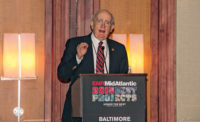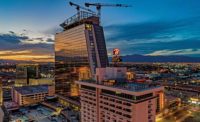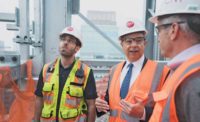An upward glance at high-rise construction sites in New York City would likely reveal Enclos Corp. workers putting finishing touches on a building facade.
The longtime curtain wall contracting specialist has played a key role in projects that include a 52-story tower at Manhattan’s Hudson Yards and its 73-story neighbor, on which the firm has just started work. Enclos also is involved with residential projects south of Central Park, including the 66-story, 472,062-sq-ft 220 Central Park South and the 96-story 432 Park Avenue as well as institutional projects such as a $45.3-million facade replacement at LaGuardia Community College in Long Island City.
The Eagan, Minn.-based firm has a presence in multiple markets, with a national reach and reputation that has propelled it to No. 39 on the ENR Top 600 Speciality Contractors list, with the firm reporting about $452 million in 2016 revenue and top-ranked among firms in the glazing and curtain wall niche. Jeffrey Vaglio, Enclos vice president, says the last several years of steady revenue growth on the East Coast have been highlighted by New York City’s building boom.
“The growth has truly been a mix of commercial and residential projects,” Vaglio says, noting that all share the trait of being supertall buildings—more than 984 ft tall, according to the Council on Tall Buildings and Urban Habitat—driven in large part by developers’ desire to provide unparalleled views for luxury condo developments.
That trend meshes with Enclos’ expertise in prefabrication, which Vaglio says “is at the core of our business model.” He explains that curtain wall units are glazed and assembled off site in a controlled environment, then scheduled for just-in-time delivery whenever possible. They also use interlocking details that reduce field activities such as applying joint sealants.
“With dense urban sites, limited footprints and aggressive construction schedules, prefabricated unitized curtain wall enclosure systems make a lot of sense” for supertall projects, Vaglio adds.
Intensive Innovation
Enclos has also benefited from an array of technology tools, many of which have been researched and refined for building skin applications in the firm’s advanced technology studio, launched in the Los Angeles office in 2009 and complemented with an East Coast counterpart two years later.
Vaglio, who heads the studio, says the operation is more than just a company-defined “facade skunk works” for exploring new technologies and approaches for building skin designs and constructibility.
“It’s the initial technical design interface of our organization with our clients,” he says, noting that it complements the firm’s longtime collaborations with owners, construction managers and general contractors, with an emphasis on relating to project architects, engineers and consultants.
In addition, the studio team constantly explores issues that Vaglio says will foster “more intelligent conversations with project teams” about performance issues such as thermal and acoustics, geometrical challenges such as cold-formed glass and material advancements in the vast array of transparent, translucent and opaque materials being integrated into building enclosures.
The studio works with 3D modeling tools and aims to get to full-scale as early as possible, using rapid prototyping to convert a technical detail into a tangible physical object.
“One huge advantage offered by the studio is our visualization skills that help project teams visualize the intent of our field operations early on,” Vaglio says. “We use renderings and animations to convey field crew, equipment, procedures and safety. These tools help get all parties on the same page.”
As an example of Enclos’ constructibility problem-solving prowess, Vaglio points to VIA 57 West, a 39-story, $76-million residential project completed in 2016 with the Hunter Roberts Construction Group as general contractor. The 861,113-sq-ft building’s double-curved form helps it blend with its low-rise neighbors. Yet the prospect of making this distinctive profile a reality presented a 515,200-sq-ft installation challenge that Vaglio says was solved via a design-assist collaboration with architect Bjarke Ingels Group.
“Together, we derived a subdivision—completely comprised of one-off unit geometries—that met design intent, accommodated maintenance equipment and integrated guttering based on flow-accumulations across surface,” Vaglio explains, adding that the project was the impetus for proactively integrating laser tracking into the component manufacturing process.
And for those day-to-day construction problems that technology couldn’t predict, James McKenna, president at Hunter Roberts, says Enclos “did whatever it took” to solve them. “They erected panels 24 hours a day, with excellent and performance-tested quality results,” he says.
Ever-Evolving Culture
Working on the exteriors of such lofty projects requires a special emphasis on safety, which Vaglio says revolves around good project team communication.
Enclos President Bruce Bornhurst, who assumed the role in January 2016 after heading the firm’s West Coast sales and operations for more than 30 years, would like to do more in the safety arena. He says Enclos is “still in the infancy of an organizational redirect” that he hopes will “engage everyone within the company to facilitate a Work Safe Home Safe environment by bringing awareness to their individual ability to positively influence the well-being of our entire staff.”
Vaglio credits field crews for real innovations, “identifying a smarter way to do something, but needing a custom piece of equipment to do it.” Drawing on that input, Enclos’ applications engineering and kinetics experts have come up with solutions that have benefited several New York projects.
For example, at 53W53, a 77-story, 1,050-ft supertall building currently under construction, the combination of sloping conditions and a concrete diagrid structure presented hard-to-reach sloped corner conditions for installing 394,384 sq ft of curtain wall.
“A series of custom column jib apparatuses was developed to be able to lift material outside the building before swinging it into the otherwise hard-to-reach final position,” Vaglio says.
Ahead of the Curve
Bornhurst also hopes to keep Enclos ahead of the curve by continually intensifying competition for new talent. Offering opportunities to work on stimulating, high-visibility facade and curtain wall projects is not always enough in today’s market.
“We find the best outcome relies on integrating bright young talent early,” he says, “then working with each individual on their development on multiple fronts.” A key component of Enclos’ succession opportunities through advanced rotation (SOAR)—a three-phase internal career development program— includes extended stints in the firm’s various operations over 24 months, followed by enhanced training in management and leadership.
Cultivating that talent, Bornhurst believes, is essential to keep Enclos at the forefront of its specialty and thereby make the firm what McKenna calls “a must go-to resource” for curtain wall construction.












Post a comment to this article
Report Abusive Comment